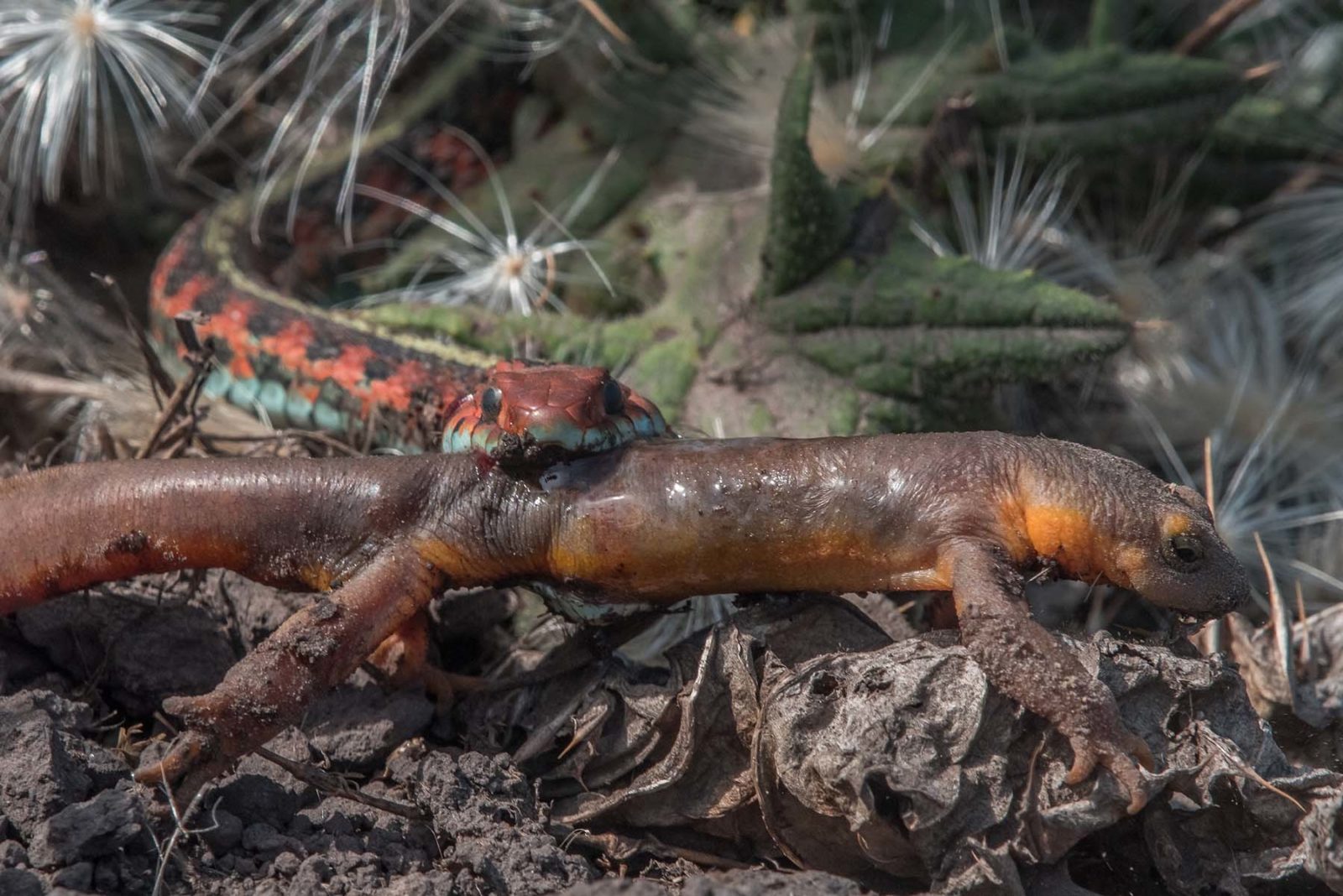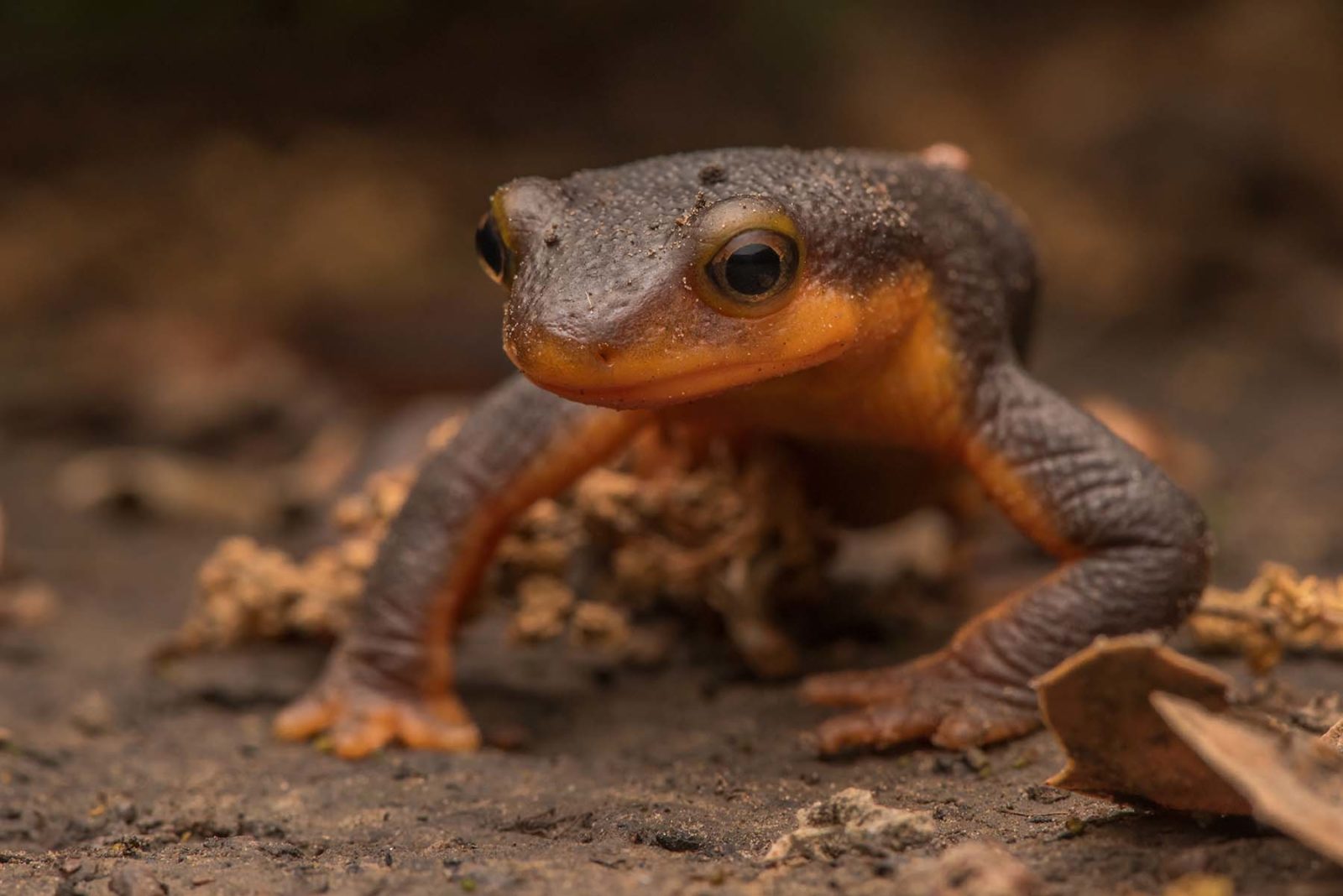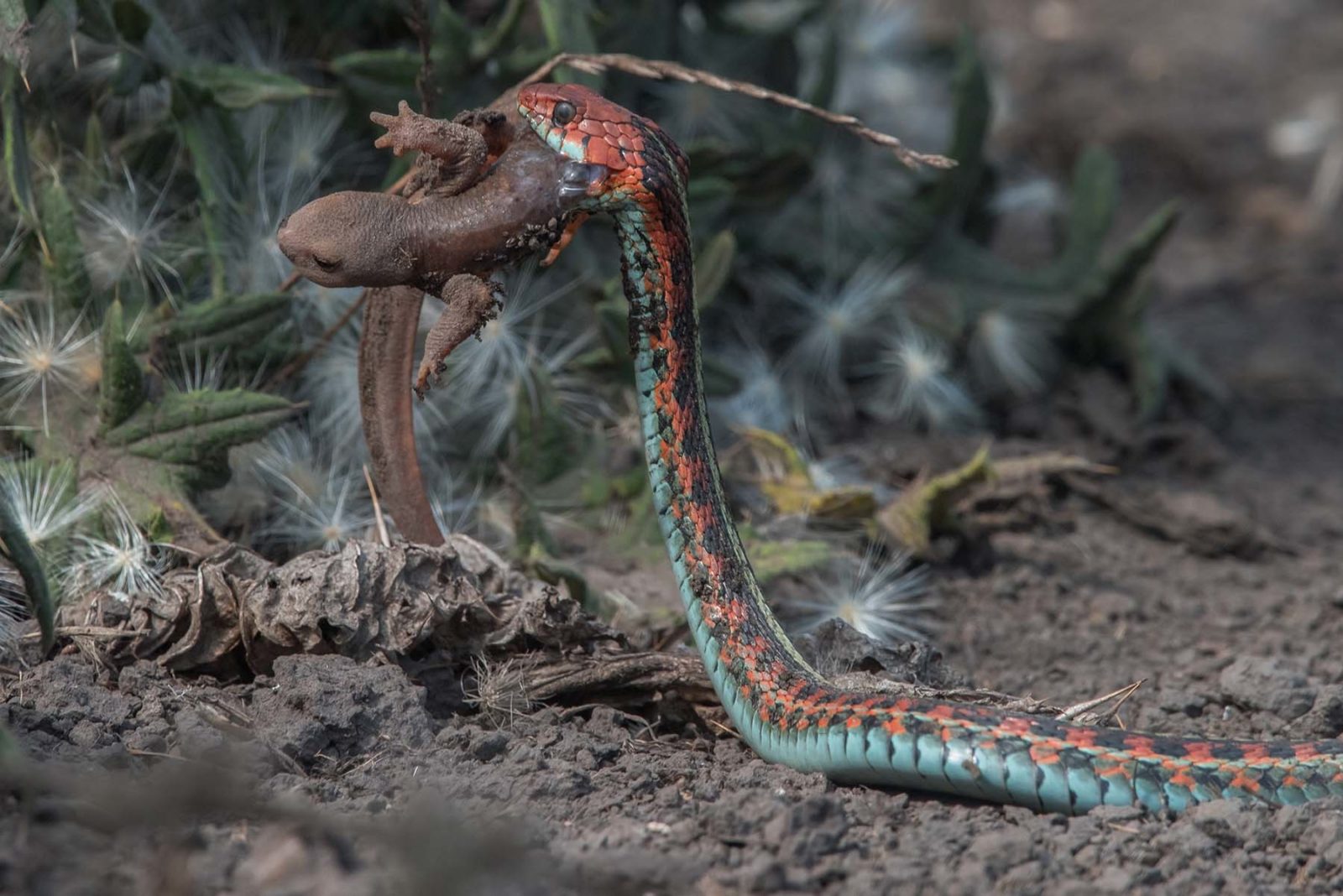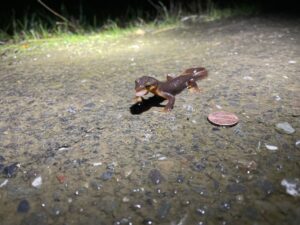
At first glance, a newt seems defenseless. It lacks any of the armaments we deem threatening in the animal kingdom. It has no big claws, no sharp teeth, no stinger. But newts in the Bay Area have something far more potent when it comes to protection. Their skin contains an infamously deadly neurotoxin, tetrodotoxin (TTX), that’s more than 1,000 times more potent than cyanide.
All four species of Californian newt – rough-skinned (Taricha granulosa), California (Taricha torosa), red-bellied (Taricha rivularis) and Sierra (Taricha sierrae) — contain TTX, with rough-skinned newts having the highest levels. Not just trace amounts of TTX either: one especially potent newt may have enough neurotoxin to fatally poison 20 people. The good news for us is that the most toxic of newts are totally innocuous if not eaten – the bad news for gartersnakes is that eating newts is exactly what they have in mind. Yet somehow some gartersnakes survive eating newts that should be poisonous enough to kill thousands of snakes.
The snake’s dietary preference for newts kickstarted what scientists refer to as an evolutionary arms race, an escalating series of adaptations and co-adaptations between species. In this case, the race is between the newt’s toxicity and snake’s shocking ability to survive ingesting toxin, and it all started before snakes even existed. First, approximately 170 million years ago when there were only lizards, some of the reptiles had a mutation in a gene affecting their sodium channels, incidentally conferring TTX resistance. When a branch of lizards split off and turned into modern-day snakes this gene sat in the genetic code unused as far as TTX resistance, being passed down to descendants for millions of years. Toxic newts arrived on scene 45 million years ago (give or take a few million), and snakes were already poised to take advantage of the situation. The race was afoot! The gartersnakes were resistant enough to feed on newts, but the more toxic newts had a survival advantage – the increased likelihood of them passing down their genes meant the overall toxicity of the amphibian population shifted upwards. Evolution had an answer – a series of further gene mutations led to more resistant snakes – and that favorable trait was passed down. The race kept going, predator and prey leapfrogging each other in terms of toxicity and resistance, becoming more toxic and more resistant resulting in super-toxic newts and hyper resistant snakes.

Dozens of researchers have worked on this system but two names repeatedly leap out; Dr. Edmund Brodie Jr and Dr. Edmund ”Butch” Brodie III. The Brodies are a father and son team whose efforts have shed light on the evolution of competing species. The younger Brodie, Butch, was working on his graduate studies in Oregon when he kept observing gartersnakes that ate newts. His father had researched newts in the past, demonstrating the efficacy of the newt’s defenses and showing their toxins to be frighteningly potent – so the snakes feeding on them sparked Butch’s curiosity. Together with his father, they conducted a study that would go on to spur years of high-profile research and change our understanding of evolution.
Gartersnakes in populations that fed on newts were resistant to TTX, the Brodies found, whereas the same species from different populations where newts were not consumed had no real resistance and would succumb to comparable levels of TTX. Moreso, toxic newts were always found with resistant snakes! The geographical variation in the pattern surprised Butch. “If you looked at newts and snakes from Northern California, you would never suspect an arms race — the newts aren’t toxic, and snakes aren’t resistant,” Butch Brodie says. “But if you go to the SF Bay Area…. newts are super-toxic.”

The animals in the Bay Area offer strong evidence that the rate of evolution is not uniform everywhere — there are cool and hot spots. The result is an evolutionary contest peaking in our region. “The most resistant snakes we see anywhere in the world are from the Bay Area,” Butch Brodie says. Some snakes “from the Santa Cruz area are 10-100 times more resistant than any other snakes we’ve seen.”
As you move away from the Bay Area epicenter, the snake’s resistance to TTX gradually decreases. “We don’t know what would have pushed evolution this far, it might have to do with the ecology of newts and snakes in the vernal pools in the area,” Brodie says. “When garter snakes are born in the late summer, they often live under mats of drying pond vegetation … That happens to be where the newly metamorphosed newts come out in the fall, and we suspect there could be a lot of interaction between predator and prey just because of this overlap in microenvironment. That could have led to strong selection in the past that resulted in such high levels of resistance.”
Why not just go for easier prey? In every area where newts occur there are alternate prey items. And it seems clear, Brodie says, the snakes don’t need to eat newts. “This is not the classic specialized system of natural consumers and prey, like monarchs [entirely dependent on] milkweed hosts,” he says. “Where we have good data, maybe 1-2 percent of snake diet is newts. That makes it hard to understand how selection can be strong enough to force snakes into evolving resistance to an occasional food item.”
But yet, we know that it does – so perhaps there are periodic periods of scarcity when eating newts can offset starvation?

Even for resistant snakes, eating toxic newts is not without its drawbacks. The mutation that bestows TTX resistance also decreases muscle function. Resistant snakes slither more slowly than their nonresistant counterparts, important when it comes to evading their own predators. Toxin-tolerant snakes can still struggle when attacking a newt — if they don’t subdue and swallow it quickly their mouths become numb, the snakes become lethargic, and a determined newt can make an escape leaving a gulping ”TTX drunk” snake in its wake. The cost of producing high levels of TTX in newts is less clear – scientists are still trying to determine how newts produce the neurotoxin. Recent research shows that at least a portion might be made by bacteria that live on the newt. This revelation may change the hard-won understanding of the system we’ve gained so far, Brodie acknowledges – changing a linear one-on-one race to a complex multispecies coevolutionary trajectory.
When researchers looked at snake livers, they found that snakes that fed on toxic newts retained TTX for days or weeks after their meal. So much that they were still deadly to their predators when eaten. Could this explain how even a rare food item has had a disproportionate effect on the snake’s evolution? Consuming a newt not only offers an advantage of sustenance, but loads the snake with protective poison. However, as of yet, it’s unknown if potential gartersnake predators selectively avoid eating snakes in newt-dense areas or can somehow sense the chemical protection.
A winner may be emerging in the evolutionary arms race. Some gartersnakes have become so resistant that they are functionally impervious to TTX – at least in the magnitudes physically possible for newts to contain. No matter how poisonous a newt is, local snakes will survive eating it. Will this eventually lead to de-escalation, then perhaps another race? So far we only have hypotheses but it’s unlikely this race spanning millions of years has reached its conclusion yet. There is no doubt that generations of biologists will continue scrutinizing this system in the Bay Area and elsewhere, following threads of investigation as serpentine as the snakes themselves.




